Aggressive skates Buying Guide

Aggressive skating is fundamentally about creative flair and innovation. Your selection of aggressive skates will be a key factor in your blading journey. This guide offers valuable insights and recommendations for anyone in the market for new aggressive inline skates.
Overview
Overview
Determining the Right Size for Aggressive Inline skates
When determining the size of aggressive skates, it’s crucial to avoid simply selecting a pair based on your usual shoe size. Instead, use a measuring tape to determine the precise length of your longest foot.
With an exact foot length measurement, selecting the correct size becomes straightforward. Each aggressive skate model on our homepage comes with a size guide that allows you to select the appropriate size based on foot length. The size guides are in millimetres, following the Mondopoint-system for simple size conversion.
Steps for Measuring Your Foot

- Choose a solid, even surface to stand on.
- Wear the socks intended for skating.
- Place a piece of paper flat against the wall.
- Position your heel against the wall with your foot flat on the paper.
- Mark the point where your longest toe extends to.
- Measure from the wall or paper's edge to your mark.
- Repeat this for both feet and use the larger measurement to determine your skate size.
The Perfect Fit for Aggressive skates
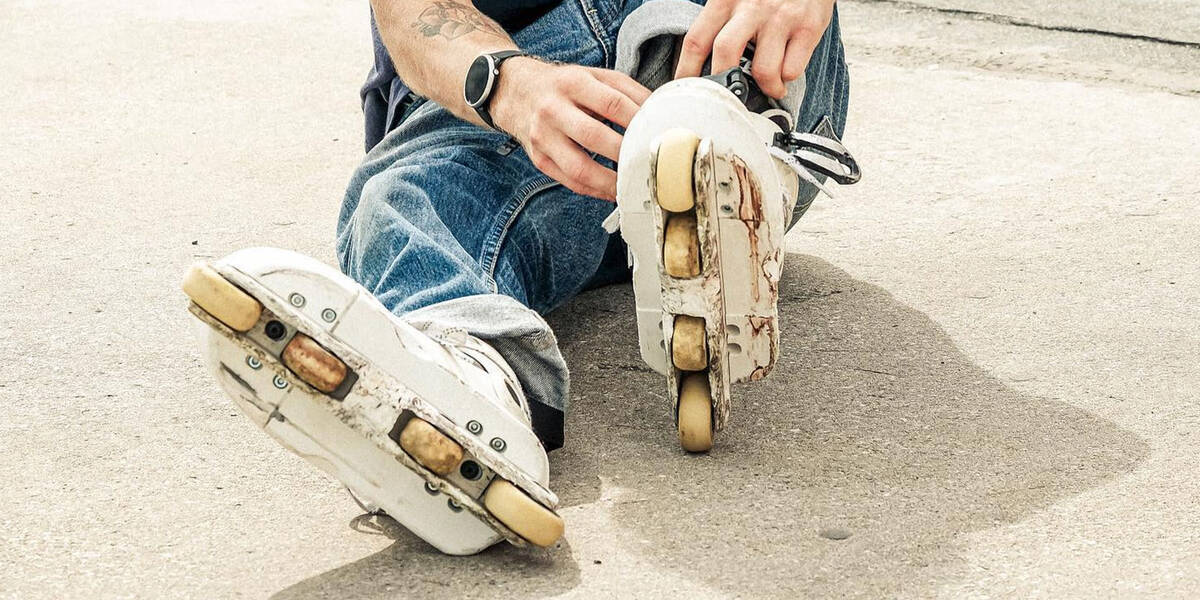
Your aggressive skates should hug your foot closely for absolute control during stunts. Extra space inside trick skates can cause foot slippage, leading to blisters and compromised control. Larger skates add weight, complicating trick performance.
In essence: A tight fit without cramping your foot and toes optimises performance.
Tips for Breaking-In Aggressive skates
New aggressive skates might need a break-in period for enhanced comfort. They should fit snugly, with the liner conforming to your foot shape gradually.
Consider these tips for breaking in aggressive skates:
- Utilise thick socks to minimise friction and avoid blisters.
- Wear the skates during other activities to acclimatise to them.
- Begin with short sessions and slowly lengthen them.
- Ensure laces and buckles are secure for a comfortable fit.
One advantage of aggressive skates is the option to replace worn liners with new ones.
Anatomy of Aggressive skates – Understanding Aggressive skates

- Boot: Constructed with hard boots or shells for durability.
- Frame: Sturdy frames to withstand grinds and impacts.
- Wheels: Small wheels provide better stability and control.
- Soul plate: Enhances grinding possibilities.
- H-block: H-blocks designed for grinding.
Aggressive skates are built for performing tricks, grinds, and jumps on streets and in skateparks, transforming any obstacle into an opportunity for new tricks and adventures. These skates are unrivalled for grinding, as no other skate type is specifically crafted for it.
Aggressive skates are equipped with smaller wheels than other inline skates, lowering the centre of gravity and enhancing control. This makes them extremely agile, allowing for diverse tricks. Although these features are great for tricks, for commuting, long-distance skating, quick urban travels, or fitness, skates with larger wheels are more suitable.
Choosing Aggressive Skate Wheels

Key elements of aggressive wheels include wheel diameter, hardness, and profile. These factors greatly impact your skating experience.
Each parameter can be customised to complement your style and the surfaces you frequently encounter. This customisation ensures you maximise your aggressive skate experience.
Diameter for Aggressive Skate Wheels
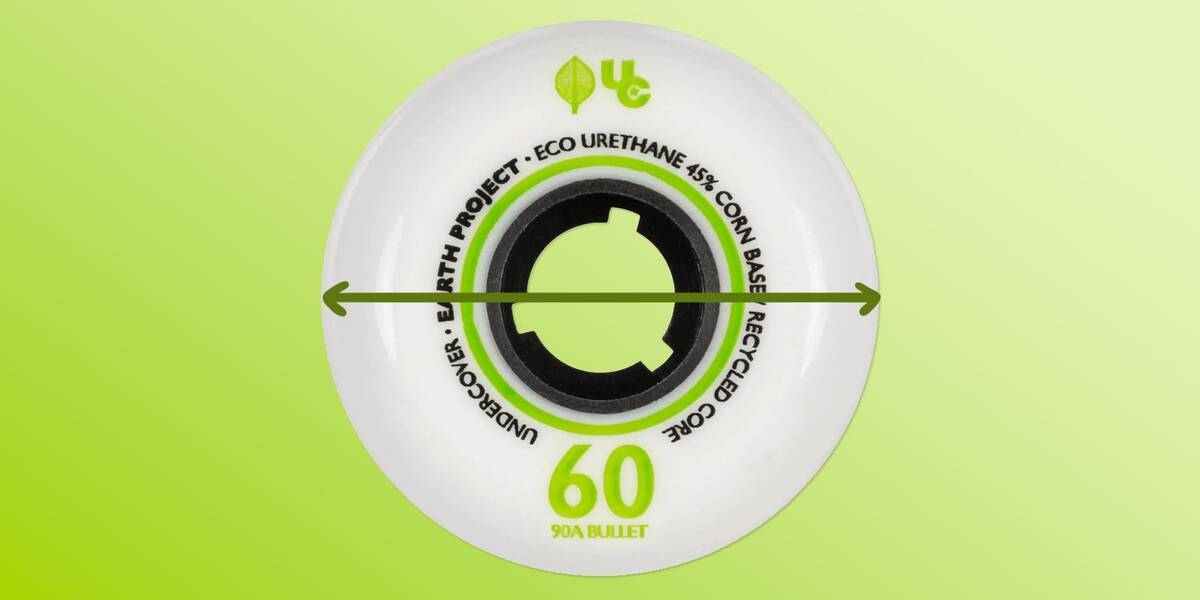
Aggressive skate wheels typically fall within the 56-60 mm range, though sizes can vary from 54 to 80 mm.
- Larger wheels (60-80 mm): Offer speed but less stability, increasing the complexity of technical tricks.
- Smaller wheels (56-58 mm): More stable but slower.
If you're after standard-sized aggressive skate wheels, consider models with 58 or 60 mm diameter wheels.
Profile of Aggressive Skate Wheels

Typically, aggressive inline wheels have a flat profile, although some may be more rounded or pointy.
- Flat profile: Enhances stability and control for landing tricks.
- Rounded profile: Offers agility with reduced grip, lessening the likelihood of wheel bite on rails.
- Pointy profile: Provides speed and easier turning with reduced friction (less common in aggressive skating).
For trick-heavy aggressive skating, flat profile wheels are generally advisable, but if you desire additional agility and speed, a rounder profile may be an option.
Wheel Hardness for Aggressive skates
Aggressive skate wheel hardness is evaluated on the durometer scale, typically ranging from 86A to 95A. A higher durometer signifies harder wheels.
- Harder wheels: Roll efficiently on smooth terrains but absorb fewer vibrations, making rougher surfaces less comfortable. They facilitate easier slides and have a reduced risk of wheel bite during grinds.
- Softer wheels: Provide better stability, enhanced vibration absorption, and increased grip on surfaces.
Consider the benefits and drawbacks of harder versus softer wheels in relation to your preferences and skating style.
Wheel Configurations in Aggressive skates
There are either flat wheel configurations or anti-rocker wheel configurations in aggressive skates. These relate to the line traced by the wheels when mounted, significantly influencing the ride experience and are essential when selecting new aggressive inline skates.
Understanding Anti-Rocker Configurations
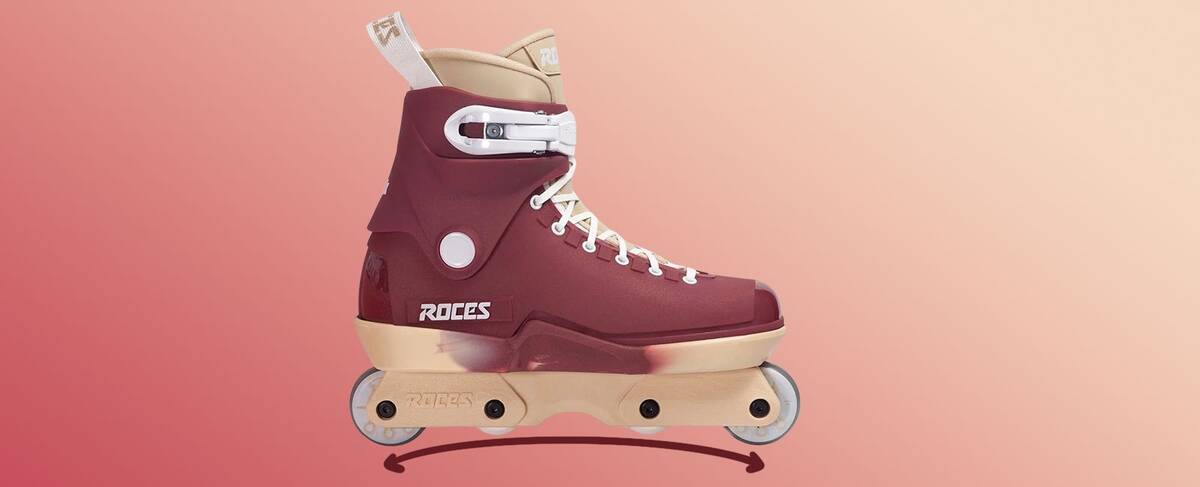
Anti-rocker configurations feature larger front and rear wheels, with smaller middle wheels creating space for grinds, making turning more challenging compared to flat setups. The contact formed by the anti-rocker setup makes turns more difficult than in flat or rocker configurations. If anti-rocker's rigidity isn't appealing and you want to emphasise grinds, consider a flat wheel setup.
What Defines Anti-Rocker Wheels?
These are the central wheels on aggressive inline skates with an anti-rocker setup, smaller and often much harder than outer wheels and do not touch the ground when rolling. Their purpose is to facilitate easy locking during various grinds without interfering. Constructed from a hard PU compound, they prevent sticking to rails.
The name "anti-rocker" comes from their smaller stature, creating an upward gap between the ground and wheel base, contrasting with rocker configurations where outer wheels are slightly smaller than those in the centre for a rocking effect.
Are Bearings Necessary for Anti-Rocker Wheels?
Having bearings in anti-rocker wheels can be helpful for activities such as stair bashing (descending stairs), enabling smooth wheel movement on stairs. Also called grind wheels, their primary purpose is to stop wheels from sticking during H-block grinds, so bearings are not essential. Some anti-rocker wheels have bearings, while others do not.
Exploring Flat Configurations in Aggressive skates
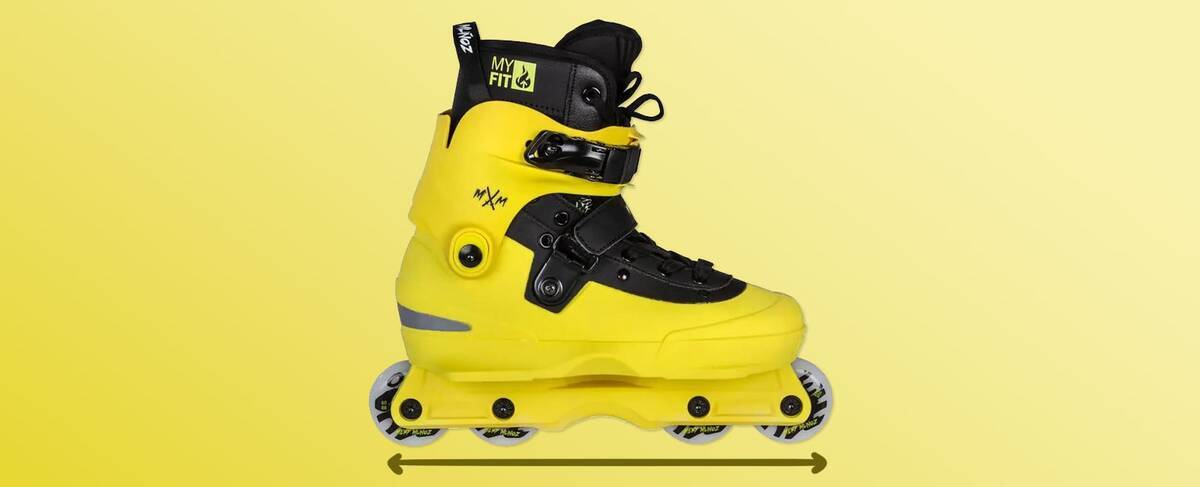
In flat configurations, all four wheels match in size, offering enhanced speed and manoeuvrability compared to anti-rocker setups. Flat setups demand greater accuracy during groove grinds due to the middle wheels' potential to snag on rails. Not all frames can fit flat setups due to limited space available for central wheels.
Flat setups are highly recommended for new inline skaters venturing into aggressive skating. Many seasoned aggressive skaters favour flat setups due to the style and precision they entail during H-block grinds.
Flat Versus Anti-Rocker
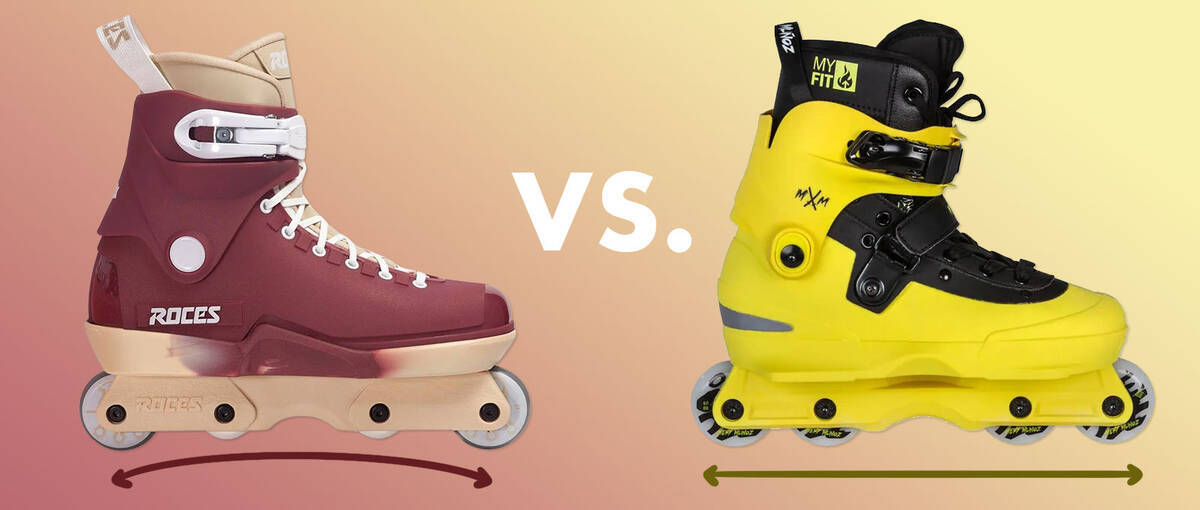
Whether novice or expert, deciding between an anti-rocker or flat setup ultimately boils down to preference, as neither is objectively superior.
Consider these aspects when buying new skates if uncertain about which setup to choose:
- Groove Grinds with Anti-Rockers: The smaller anti-rocker wheels minimise wheel bite during H-block grinds.
- Groove Grinds with Flat Setups: Flat setups require precision, potentially leading to more stylish grinds.
- Speed: Flat setups are faster than anti-rocker setups.
- Maneuverability: Turning is smoother with flat setups, improving riding experiences in bowls and parks.
- Novice Inline Skaters: Learning to skate is easier with flat setups.
- New to Aggressive skates: Preferred for ease in learning grinds, although experience with inline skating can make anti-rockers more suitable for easier grinding.
Your selection depends on your skating approach and what you prioritise in skating, and whether you are new to inline skating or an experienced skater transitioning to aggressive skates.
Exploring Frames for Aggressive skates

The primary functions of aggressive skate frames are to secure the wheels and serve as a platform for grinds. Since grinding plays an integral role in aggressive skating, focusing on frames is essential when deciding on the best aggressive rollerblades for your needs.
Aggressive skate frames are crafted from robust materials such as aluminium, fibreglass, or composites to endure the demands of aggressive skating. Almost all frames follow the Universal Frame System (UFS), guaranteeing compatibility with any brand of aggressive boots.
Some aggressive frames are crafted for a particular wheel setup, whereas others allow for multiple configurations. Should you buy skates with a flat wheel arrangement, it's possible to switch them to an anti-rocker setup by installing smaller wheels in the middle, thereby improving your ability to grind.
Not every frame is suitable for a flat setup, meaning that switching from an anti-rocker setup to a flat one requires careful assessment. You may use a calliper to determine if it’s achievable, but it might be more convenient to refer to the manufacturer's specifications. Verify that the frames are indicated as compatible with a flat setup, then check the maximum wheel diameter and locate a set of eight wheels that meet or are below the maximum wheel diameter of your frame.
Understanding the Universal Frame System
All UFS frames can be exchanged for any other UFS frame, irrespective of brand and size.
Due to the broad adherence to the Universal Frame System (UFS), it is straightforward to replace worn frames, preserving the life and efficiency of your skates.
The Universal Frame System (UFS) serves as the standard method for attaching frames to boots on aggressive skates. With UFS, you may pair boots and frames as you see fit, forming your custom aggressive skate configuration. Altering frames on a UFS boot is simple, as aggressive skate makers have consented to this standard.
Specifications for the Universal Frame System (UFS)
- Distance Between Mounting Holes: 167mm
- UFS Mounting Hole Diameter: 20mm
- UFS Mounting Hole Depth: 3mm
- UFS Frame Width: 41mm
- Mounting: Frames are secured with two bolts fastened into the mounting holes
The bolts used in UFS installations differ in length across frames. Although the mounting hole spacing is consistent across all models, the frame lengths are not dictated by the UFS.
Exploring Soulplates

Soul plates are a distinctive aspect of aggressive skates, primarily intended for grinding and shielding the skates from damage. Positioned between the frames and the boots, soul plates of aggressive skates are constructed from robust plastic materials.
These are essential to the skate's function, allowing for seamless grinds on a variety of surfaces. The soul grind, an initial technique for newcomers, engages the foot closest to the rail grinding on the soul plate, while the opposite leg stretches forward to grind on the H-block. A primary challenge for a novice aggressive skater is getting the soul plate to fasten onto a kerb or rail.
Bearings for Aggressive skates
Bearings within aggressive skate wheels are vital for guaranteeing smooth rotation. Due to the intense impact of aggressive skating, these bearings need frequent replacement to keep performance at its peak and enable effective stunt execution. Fresh bearings provide a smooth roll, essential for reaching top performance during tricks. Bearings are easily obtainable as spare parts for straightforward replacement.
At SkatePro, we classify bearings on the ABEC scale, ranging from 1 to 9, to evaluate their precision. Typically, a higher ABEC rating ensures a smoother rolling experience.
It’s crucial to note that the ABEC rating does not reflect the durability of a bearing. Therefore, we suggest selecting bearings from esteemed brands instead of focusing only on the ABEC rating.
Are Aggressive skates Suitable for Inline skate Beginners?
For someone new to inline skating, aggressive skates can be a viable choice if the aim is to pursue aggressive skating. Should your preference lean towards fitness, freeriding, marathons, or alternate inline disciplines, it is advisable to select a different type of skate. However, if your interest lies in aggressive blading, your initial pair should definitely be aggressive skates. Here are some factors to ponder:
- Stability: With their smaller wheels, aggressive skates provide increased stability, which benefits beginners by simplifying the basics of inline skating.
- Terrain: Due to smaller wheels and a heftier build, aggressive skates are not optimal for rough or uneven terrains. This is a drawback and a core reason why they are mainly recommended for those focusing on aggressive skating.
- Flat Setup: For those without previous inline skating experience, opting for aggressive skates with a flat wheel arrangement, where all eight wheels share the same diameter, facilitates learning strides and offers a smooth roll.
If you are uncertain whether aggressive inline skates are right for you, exploring various inline and roller skate types could be beneficial:
